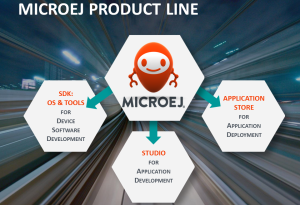MicroEJ will unveil the latest version of its MicroEJ Operating System (OS), at Embedded World in Nuremberg, Germany (February 23-24, 2016).
At EclipseCon Europe, MicroEJ® introduced MicroEJ Studio, its solution for application developers; at CES2016 in Las Vegas, it introduced the MicroEJ Application Store, its solution for delivering applications to IoT devices.
MicroEJ OS says it continues to address traditional resource-constrained embedded systems, while version 4 adds capabilities dedicated to IoT devices. IoT devices are embedded systems with strong performance, footprint and reliability constraints. In addition, IoT devices interact with cloud platforms by being connected to the internet either directly or through a gateway or mobile companion. They also offer new experiences to their users beyond their core functionality (for example, beyond giving the temperature, a smart thermostat may also act as a gateway and control other connected devices in the home through a local wireless network).
Smartphones and tablets have set new standards and expectations in terms of user experience and services delivered through applications (apps) downloaded from stores (or marketplaces). MicroEJ OS 4 enables delivery of similar app-driven experiences and services to devices that can’t afford to run mobile platforms. While a mobile OS typically requires gigabytes of memory and storage, and gigahertz multi-core microprocessors, which leads to high-cost hardware, MicroEJ OS can run on low-power, low-cost megahertz microcontrollers in the range of kilobytes of memory and storage. MicroEJ OS allows manufacturers to save up to 60% on the bill of materials and increase up to 80% in the battery life of their devices when compared to mobile operating systems.
MicroEJ OS 4 offers the following key capabilities with the aim of delivering on the IoT promise:
- Scalability: MicroEJ OS can be built by device manufacturers with just the components required for supporting available hardware functions and delivering needed software services, thus optimising the total software footprint and reducing expensive RAM and flash sizes (starting at 30KB).
- Portability: MicroEJ executes applications written for the popular C and Java languages (used by an estimated 10 million developers) and provides a virtualisation layer that ensures the independence of application software from hardware. This allows binary reuse of code across a range of different products and offers high productivity gains.
- Connectivity: MicroEJ supports most wired and wireless connectivity layers and protocols, for proprietary or IP-based communications, whether on narrowband connections to gateways and mobile companions or on broadband connections to the cloud.
- Security and IP protection: MicroEJ ensures that data storage and communications are fully secured through cryptography and standards such as SSL/TLS and DTLS. Users of devices securely access MicroEJ Application Store services with strong software authentication based on the OAuth protocol. Apps and devices are securely identified with unique IDs and signed certificates. In addition to protecting users and their data, MicroEJ OS and associated tools make reverse engineering very complex, ensuring that the device manufacturer’s software intellectual property (IP) is protected.
- User interface: MicroEJ OS 4 introduces its newest 2D graphics and touch library MicroUI version 2, as well as its new Micro Widget Toolkit (MWT) for designing attractive, natural and fast/responsive user interfaces. MicroUI supports any form, size, color depth and resolution of displays, and provides advanced capabilities that used to be reserved to high-end devices, such as transparency, anti-aliasing, any image formats, multi-language fonts, multi-touch, etc.
- Multi-app execution engine: MicroEJ OS ensures that downloaded apps execute safely and independently from each other by providing an isolation layer (sandbox) between apps and by controlling their access to system resources and API in order to avoid malicious code or to enforce business rules. Apps are verified at build time when published to the MicroEJ Application Store so their execution on the target device is guaranteed (no link-time error/missing dependencies). They are loaded in binary format and executed in place (in RAM or Flash); they don’t need to be built on the device itself after loading, so performance and memory are optimised.
MicroEJ OS resides on hardware-dependent software foundations, sitting either directly on the hardware (“bare metal”) or on top of a real-time kernel (a.k.a. RTOS) and associated native libraries (such as TCP/IP, File System, USB stacks). Supported RTOS are delivered by partner vendors like Micrium, SEGGER, Express Logic, or available in open source like FreeRTOS, or provided by semiconductor vendors like STMicroelectronics STM32Cube, NXP Kinetis SDK and Renesas Synergy Software Package (SSP). Supported SSL library provider is wolfSSL.
Visit MicroEJ at Embedded World in Booth #4-259 (in Hall 4) at the Nuremberg Exhibition Centre in Nuremberg, Germany from February 23-24, 2016.
Comment on this article below or via Twitter: @IoTNow_ OR @jcIoTnow










